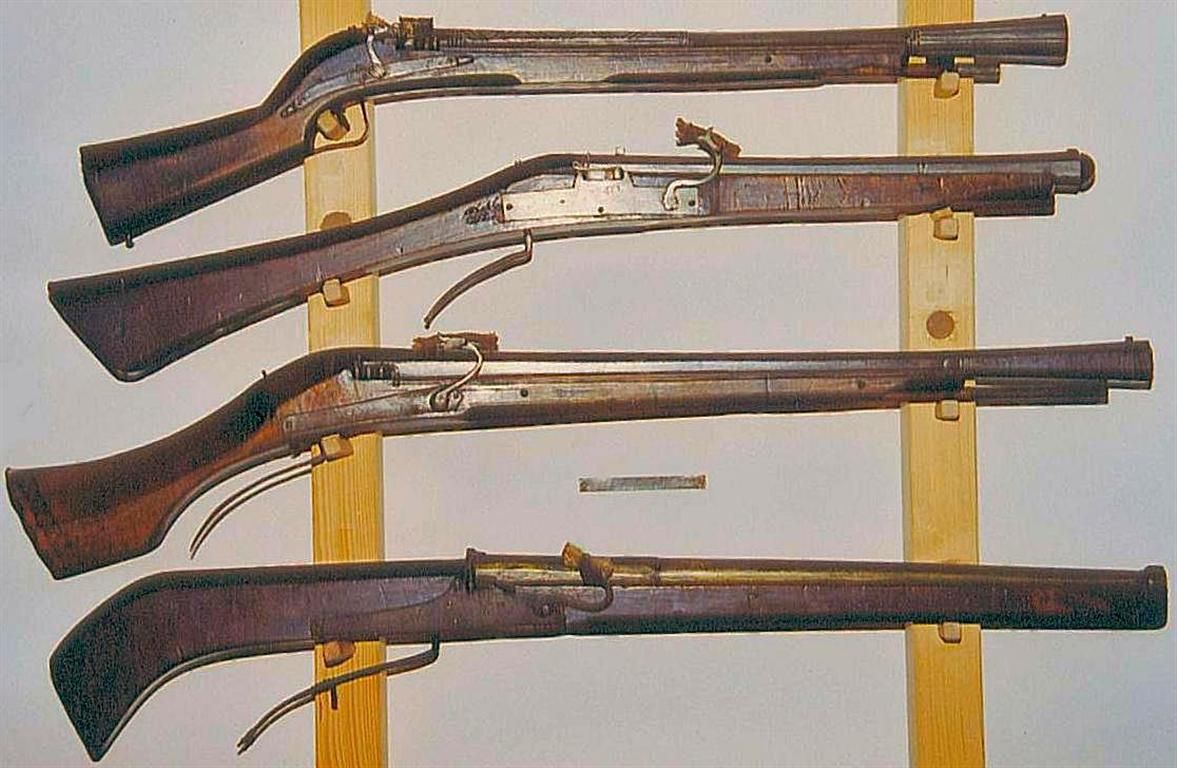Description for above, and a surprise!! :bow:
now, here are my four harquebuses!
The one on top with the snap-matchlock was made in Tusco-Emilia, Northern Italy, ca. 1520, the finely carved barrel bearing an E mark also found on cinquedeas of early 16th century date. This one my well have seen use in the Battle of Pavia in 1525. For comparison, I attach a detail of a ca. 1540 Brescia/North Italian harquebus of three in the Royal Armouries Leeds, inv.no. XII.5315.
The second from top is of earliest Suhl/Thuringia, Germany, make, ca. 1540. The Suhl workshops started in the 1530's, with workers coming in from Nuremberg.
The next down in line is struck twice on the barrel with a Nuremberg crossed arrows mark also found on crossbow cranequins, and the date 1539 - see detail. An almost identical specimen with the same date and marks is on display in the Germanisches Nationalmuseum in Nuremberg (inv.no. W 494).
The one at the bottom features an early 'Maximilian' brass or bronze barrel of ca. 1490 and was restocked in about 1520. Its present lock of ca. 1560 is most probably a rough 'modernization' from the time of re-use in the Thirty Years War - as happened to many guns in European armories that had become obsolete by the 1640's when any piece that could still fire was badly needed.
Yes, i did fire the third harquebus from top, dated 1539, twice some years ago.
No problem at all as the barrels of these 16th century guns have unusually thick walls but are of relatively small bore; eg., the outer diameter at the muzzle of that harquebus is about 3,8 cm, the bore is 'only' 16 mm.
You sometimes find such barrels, almost 500 years old, in later stocks and mounted with flintlocks or even percussion ignition. Not enough said, their re-users in the 17th to the 19th centuries often even drilled the original bores out to ca. 20 mm and more!
Although a caliber of ca. 20 mm should have resulted in a dangerously thin barrel wall in the middle section where these early Renaissance barrels were at their thinnest, I have never come across one that was burst. All of them seem to have survived 400 years of firing - and remember that the black powder of the 19th century was a lot stronger than that of the early 16th century used to be.
Of course, I kept that in mind when firing my piece and used a reduced load of modern black powder.
As those short, but thick barrels are comparatively heavy the recoil is not a hard as one might expect.
I have also fired various original matchlock and wheel-lock muskets from the 17th century and never occurred any problem.
Actually, the Graz armory in Styria/Austria made a sensational experiment in 1989. They had late 16th to late 17th century muskets and pistols from their collections officially state proofed with modern black powder and made various shooting tests over different firing ranges. None of those 400 year-old guns ever failed. Their piercing results on armor plates, wood and gelatine blocks were astounding.
The whole story is told and profusely illustrated in the catalog, Von alten Handfeuerwaffen: Entwicklung, Technik, Leistung. Landeszeughaus Graz, 1989 (no ISBN, but sometimes offered by antiquarian bookshops on the internet).
Never underestimate the crafts of barrel smiths of 500 years ago and the enduring quality of their products!









